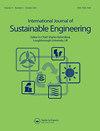Decarboxylation of oleic acid using iridium catalysis to form products of increased aromatic content compared to ruthenium systems
IF 3.6
Q3 GREEN & SUSTAINABLE SCIENCE & TECHNOLOGY
International Journal of Sustainable Engineering
Pub Date : 2021-09-15
DOI:10.1080/19397038.2021.1978589
引用次数: 2
Abstract
ABSTRACT The decarboxylation of 9-cis-octadecenoic (oleic) acid to aromatic and aliphatic hydrocarbons suitable as blend components for aviation fuel applications utilising ruthenium dodecacarbonyl [Ru3(CO)12] with a variety of other catalysts is presented. Due to the different relative rates of decarboxylation and hydrogenation/dehydrogenation, different product distributions are possible when the catalyst is varied. Chloro-1,5-cyclooctadiene iridium (I) dimer [(C8H12IrCl)2] gave a similar conversion to the ruthenium system but provided an altered product distribution. Aromatic contents of up to 35% were achieved in the iridium system, thereby providing a wider range of blending options for fuel producers. Additionally, both catalytic systems were found to decarboxylate high-oleic soybean oil fatty acids, giving a product of similar energy content to that obtained using high grade oleic acid.用铱催化油酸脱羧,形成比钌体系芳香含量增加的产物
摘要:介绍了利用十二羰基钌[Ru3(CO)12]和多种其他催化剂,将9-顺式十八烯(油酸)酸脱羧为芳香和脂肪烃,适合作为航空燃料的混合组分。由于脱羧反应和加氢/脱氢反应的相对速率不同,不同的催化剂可能产生不同的产物分布。氯-1,5-环二烯铱(I)二聚体[(C8H12IrCl)2]的转化率与钌体系相似,但产物分布发生了改变。在铱体系中实现了高达35%的芳香族含量,从而为燃料生产商提供了更广泛的混合选择。此外,发现两种催化体系都能使高油酸大豆油脂肪酸脱羧,得到的产品能量含量与使用高油酸获得的产品相似。
本文章由计算机程序翻译,如有差异,请以英文原文为准。
求助全文
约1分钟内获得全文
求助全文
来源期刊

International Journal of Sustainable Engineering
GREEN & SUSTAINABLE SCIENCE & TECHNOLOGY-
CiteScore
7.70
自引率
0.00%
发文量
19
 求助内容:
求助内容: 应助结果提醒方式:
应助结果提醒方式:


